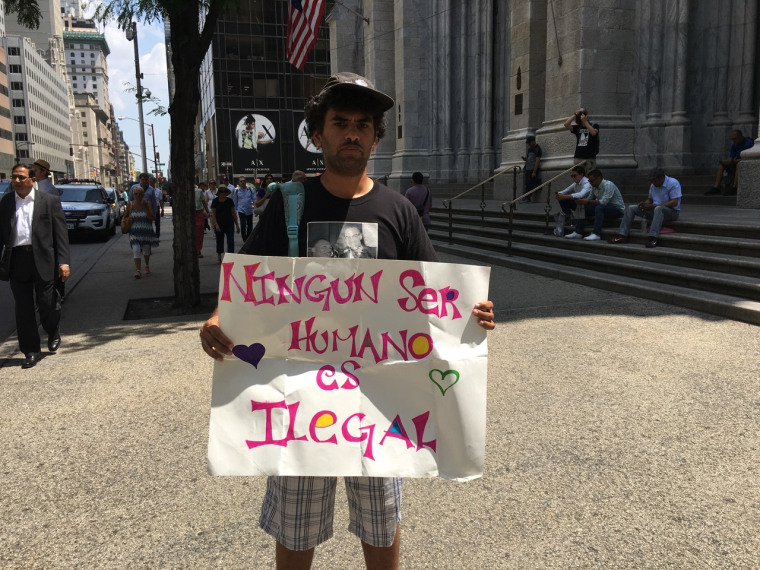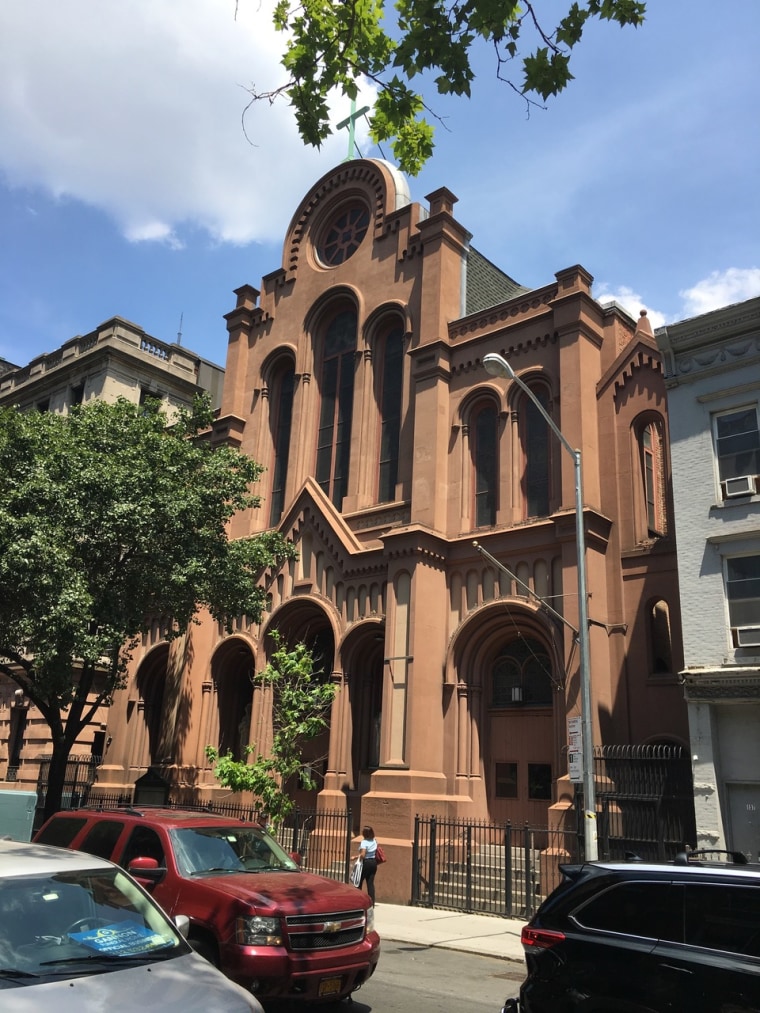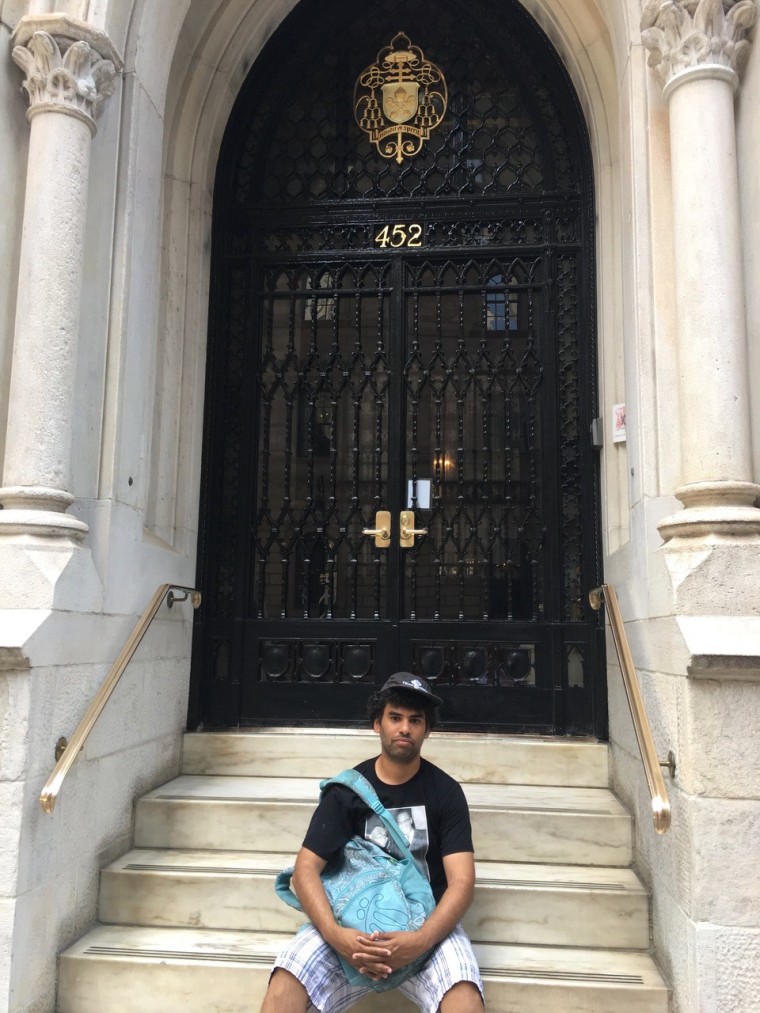Across the country, churches and congregations have rallied to offer support to undocumented immigrants facing deportation. Now one activist in Manhattan is pushing the powerful Archdiocese of New York to do more to help immigrants.
Felix Cepeda, 36, wants the Roman Catholic Church to open at least one of its shuttered churches and provide sanctuary to undocumented immigrants – a step that would be as bold as it could be potentially risky.

For weeks, Cepeda has spent every other day in front of St. Patrick’s Cathedral staging a series of fasts and vigils. He carries a sign that reads, in Spanish, “No human being is illegal.” Sometimes he speaks with curious tourists who engage him. Mostly, he sits quietly before the throngs of the faithful and the busy passing by.
The son of immigrants and a former Jesuit brother in the Dominican Republic, Cepeda is a one-man social justice mission. “I feel the Catholic Church does great work, but we can always do more,” he told NBC Latino. “I feel the church needs to step up and at least offer one undocumented person sanctuary here.”
Since 2015, the Catholic Church has closed dozens of church structures in the New York region, as part of a restructuring driven by a shortage of priests and demographic changes. Many of these buildings sit empty and unused, like the Church of Our Lady of the Scapular-St. Stephen in midtown Manhattan. Cepeda’s idea is for the church to repurpose these structures as immigrant sanctuaries, homeless shelters, and meeting spaces for community organizers.
Cepeda made his proposal in an April letter to New York Cardinal Timothy Dolan. “Not one of our open churches is offering sanctuary in NYC to undocumented immigrants facing deportation,” he wrote. “There are around 11 individuals at this moment receiving sanctuary in NYC Churches. Sadly none of these are Roman Catholic Churches.”
According to a Pew Research Center 2014 report, 35 percent of New York City’s Catholics are Hispanic. Many of them are likely undocumented, as the New York/New Jersey metro area is home to the country’s largest population of undocumented immigrants.
RELATED: Texas Border Town Sues State Over ‘Sanctuary Cities’ Ban
In a statement provided to NBC Latino on behalf of Catholic Charities and the archdiocese, Monsignor Kevin Sullivan writes: "The parishes, schools, and the charitable agencies of the Archdiocese have been welcoming immigrants to the United States for more than 200 years. We intend to continue and strengthen that legacy.”
Sullivan writes that Catholic Charities immigrant services include providing legal representation, teaching English and organizing for workplace safety. It also operates a hotline that immigrants can call for emergency assistance.
But in addition to such good works, Cepeda says he wants Dolan to visit with an undocumented family taking sanctuary in another church. He says the cardinal extending sanctuary to just one person or one family is “totally possible.”
Cepeda is acting alone – without the affiliation of any group – and is aware that his quest can be viewed as either quixotic or inspired. He is telling his story to Spanish-language and local media whenever possible, and hoping to raise awareness of his cause.
Ravi Ragbir, executive director of the New Sanctuary Coalition of New York City, supports Cepeda’s efforts.
“What he is doing, we believe in, which is individuals taking positions for dignity and humanity for all,” Ragbir said. “These are different times, and congregations with undocumented people are terrified, and (the Roman Catholic) Church not taking a position does not allay their fears.”
Churches have an important role to play when an immigrant is facing deportation, Ragbir explained. Pastors and ministers can reach out to ICE (Immigration and Customs Enforcement), for example, on behalf of a person without an attorney.
Although the New Sanctuary Coalition is comprised of multi-faith institutions, Ragbir said, Roman Catholic churches have not officially come on board.

In fact, a story in the National Catholic Reporter pointed out that, “While a large portion of undocumented immigrants under threat in New York are Catholics, it's Protestant churches that have come forth as vanguards of the fledgling sanctuary movement, which hopes to use churches as a haven for undocumented immigrants fleeing deportation.”
As the Rev. Juan Carlos Ruiz, co-founder of the New Sanctuary Coalition told NBC Latino, “Our institutions are at times lacking the thirst for justice that is needed in our communities.”
Nationwide, churches of all denominations have wrestled with the idea of providing a haven to undocumented immigrants. In March, Cardinal Blase Cupich of Chicago instructed his priests not to open parish doors to immigration agents without a warrant.
Immigration authorities have a longstanding policy of not conducting enforcement actions at “sensitive locations,” such as churches, schools, and hospitals. This policy is based on an internal memo from 2011, however, and is not law.
RELATED: Court Blunts Trump’s Sanctuary Cities Crackdown
There is a federal statute prohibiting knowingly or recklessly transporting, harboring, or shielding “aliens” from detection. Violations are punishable by fines and jail time. So churches offering sanctuary to undocumented immigrants face genuine legal risks.
Historically, the sanctuary movement can be seen as having three waves. In the 1980s, Central Americans fleeing violence in El Salvador and Guatemala began taking sanctuary in churches in major U.S. cities, until many were granted Temporary Protected Status by the U.S. government.
A second wave of sanctuary seekers appeared around 2006-2007, when a push for immigration reform was underway. Elvira Arellano, probably the most famous face of the sanctuary movement, took refuge in a Chicago church for a year beginning in 2006. The motivation for sanctuary-seekers then was to draw attention to the plight of undocumented immigrants with U.S.-born children and community ties; a public campaign was seen as a way to potentially influence immigration officials.
In the Trump era, the sanctuary movement faces new challenges. The Trump administration has ended the Obama-era deportation priorities, putting virtually all undocumented immigrants at risk for removal.
Even complying with required ICE check-ins has resulted in deportation for some undocumented immigrants. That’s one reason why a Honduran grandmother recently took sanctuary in a Quaker church in Albuquerque, New Mexico.
Just as there is no one definition of what offering sanctuary entails, there is no official number of churches and congregations participating in the sanctuary movement. Churches from Kalamazoo, Michigan to Salt Lake City, Utah have declared themselves available as sanctuaries, and there may be others offering sanctuary under the radar.

It remains to be seen whether activists like Cepeda can have a broader impact, says Neomi De Anda, assistant professor of Religious Studies at the University of Dayton.
“I’m not sure the Catholic Church is responsive to individual actions, although I do think they pay attention,” she said. “If he (Cepeda) continues to protest, and can get more people involved, then he could be on to something.”
De Anda told NBC Latino that, for churches, declaring sanctuary is a serious decision. Because the Trump administration has publicly threatened to go after institutions that are providing sanctuary, doing so could jeopardize federal funds and grants that some churches receive. And churches are reluctant to appear partisan in a time of political polarization.
De Anda is not surprised that activists like Cepeda are mobilizing. “We may see more of these actions prodding the Catholic Church to act,” she said. “The more people feel disempowered, the more likely they are to do social justice actions.”

In De Anda’s view, those churches that are going to move towards providing sanctuary have done it, while those who have not “are probably going to stay where they are.”
On Manhattan’s Madison Avenue, Cepeda gazes up at the imposing gate of Dolan’s 19th-century mansion. So far he has not received a direct response to his letter to the cardinal.
Cepeda plans to persist in his fasting and vigils as long as he can, because he believes that New York City’s Catholic Church has a moral obligation to declare sanctuary.
“I will be doing this for as long as it takes,” he said. “I hope he (Dolan) does not see me as an enemy. I am a Catholic, and I belong to his family.”
